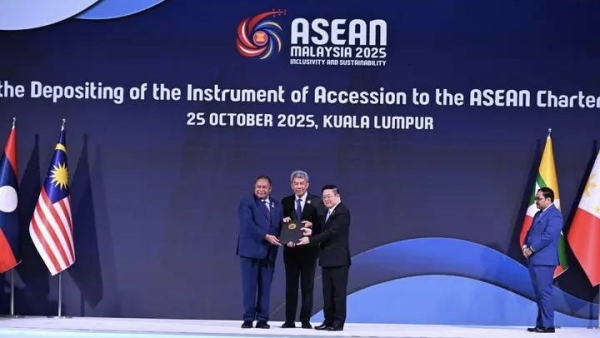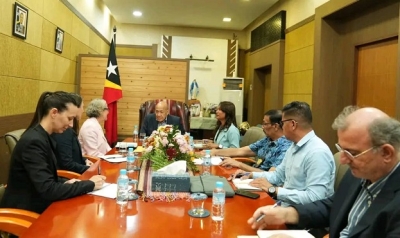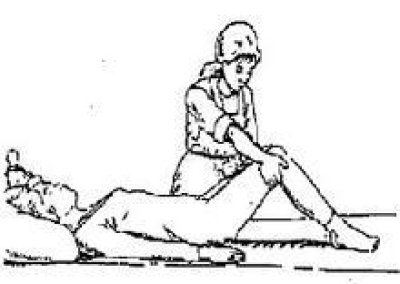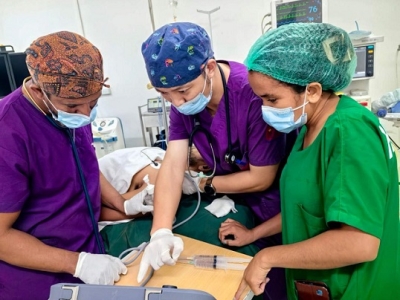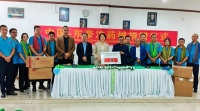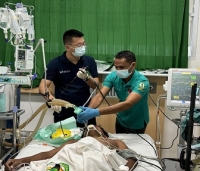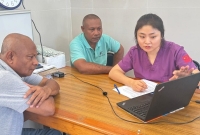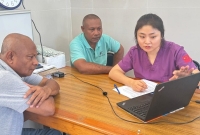KUALA LUMPUR:United States President Donald Trump has lauded Malaysia's key role in facilitating ceasefire negotiations between Thailand and Cambodia in restoring peace along the disputed border areas.
Timor-Leste's Deposited Instrument of Accession to the ASEAN Charter
DILI: The Minister of the Presidency of the Council of Ministers, Agio Pereira, accompanied by the General Director of the National Strategic Intelligence Service, Longuinhos Monteiro, met on October 24, 2025, at the Government Palace, with a delegation from the Australian Embassy in Timor-Leste, led by Ambassador Caitlin Wilson, to discuss issues related to bilateral cooperation on cybersecurity.
Chinese Medical Team-Timor-Leste Health Forum(10) Postural Transfer Training for Stroke Patients
I. Definition
Refers to the process of changing body posture and position through specific methods.
Chinese Medical Team-Timor-Leste Health Forum(9)—Real Case Awareness: Severe Pe-eclampsia and Eclampsia
She Just Wanted to Deliver Her Second Baby – But Spent 10 Days in a Coma
She was expecting her second child. In the late stage of pregnancy (around 8 months), she began having swelling and headaches. Her family thought it was normal and didn’t seek medical attention. Then one day, she collapsed with seizures and lost consciousness. She was rushed to the emergency room.
She was diagnosed with severe pre-eclampsia with eclampsia. She convulsed repeatedly and suffered two cardiac arrests before emergency surgery. After extensive resuscitation, she survived, but fell into a deep coma for 10 days. When she finally woke up, she had severe vision loss—only able to sense light.
She survived childbirth—but at a terrible cost.
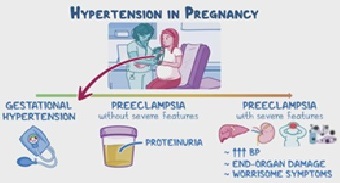
What is Gestational Hypertension?
Gestational Hypertension refers to high blood pressure (≥140/90 mmHg) that develops after 20 weeks of pregnancy in women who previously had normal blood pressure. It can progress to pre-eclampsia or eclampsia, which are dangerous for both mother and baby.
What is Pre-eclampsia and Eclampsia?
- Pre-eclampsia is a serious condition involving high blood pressure, protein in the urine, and swelling.
- Eclampsia is a progression of pre-eclampsia that causes seizures, coma, and may lead to death if untreated.
Who is at Risk?
- First-time mothers
- Women under 18 or over 35
- Women with obesity, diabetes, kidney disease, or a history of high blood pressure
- Pregnancies with twins or multiples
Warning Signs

- Persistent or severe headache
- Blurred vision or flashing lights
- Sudden swelling in face, hands, or feet
- Pain in the upper abdomen
- Blood pressure ≥140/90 mmHg
How to Prevent or Reduce Risk
- Attend all antenatal check-ups regularly
- Monitor your blood pressure and body changes
- Avoid too much salt and stay physically active
- Rest well and reduce stress
- Take warning signs seriously and seek medical help early
Final Reminder
Gestational hypertension can be managed if detected early. Every family should pay attention to mothers’ health and support them through regular care and observation.
Chinese Medical Team-Timor-Leste Health Forum(8) Precision Targeting of Postoperative Pain: Ultrasound-Guided Nerve Block Emerges as a Key Tool in Multimodal Analgesia
A fine needle, guided in real-time by ultrasound, precisely reaches the target nerve. Local anesthetic slowly diffuses, accurately blocking pain signals from the surgical site.
In the postoperative recovery ward, 68-year-old Ms. Maria actively flexes and extends her left leg, which just underwent total knee replacement surgery. A patient in the neighboring bed asks in surprise, "Aren't you in pain? When I had the same surgery last year, the pain kept me awake all night on the first day."
Ms. Maria smiles and replies, "The doctors used a new technique on me called ultrasound-guided nerve block. Now I only feel slight swelling at the wound site."
This scene is becoming increasingly common in hospitals. With the promotion of the Enhanced Recovery After Surgery (ERAS) concept, postoperative pain management has become a crucial indicator of healthcare quality.
Traditional postoperative analgesia relies heavily on opioids. However, side effects like nausea, vomiting, constipation, and respiratory depression often cause significant distress for patients. Multimodal analgesia—the combined application of analgesic methods with different mechanisms of action—has become the gold standard in modern postoperative pain management.
Within this paradigm, ultrasound-guided peripheral nerve blocks (UGPNBs) are rapidly emerging as a pivotal component.
01 The Dilemma of Traditional Analgesia
Globally, over 300 million patients undergo surgery annually, with approximately 80% experiencing moderate-to-severe postoperative pain. Opioids have long been the "mainstay" of postoperative analgesia, but their side effects are significant: about 30% of patients experience nausea and vomiting, 15% suffer constipation, and severe cases may even involve respiratory depression.
More concerningly, inadequate postoperative pain control can trigger a cascade of adverse effects: delayed wound healing, deep vein thrombosis, increased risk of pneumonia, and the potential development of chronic pain in approximately 10%-50% of patients.
Facing these challenges, the anesthesiology community proposed the multimodal analgesia strategy. The core of this concept lies in combining analgesic techniques with different mechanisms to enhance efficacy while reducing side effects.
Peripheral nerve blocks, especially precise blocks guided by ultrasound, are playing an increasingly vital role within this strategy.
02 The Key Technological Breakthrough
Peripheral nerve blocks are not new, but traditional "blind" techniques (landmark-based) have significant limitations: success rates vary widely (38%-75%), and complication risks are higher.
The introduction of ultrasound technology revolutionized this field. Using high-frequency probes, nerves, blood vessels, and surrounding structures become clearly visible. Operators can guide the needle precisely to the vicinity of the target nerve under real-time visualization.
Taking knee surgery as an example, the traditional femoral nerve block provides good analgesia but inevitably causes quadriceps weakness, increasing fall risk. Conversely, the ultrasound-guided adductor canal block (primarily targeting the saphenous nerve) provides equivalent analgesia while preserving over 90% of quadriceps strength.
"Ultrasound visualization not only facilitates identification, localization, and guidance, but also reduces complication rates, especially pneumothorax, accidental vascular puncture, and local anesthetic systemic toxicity (LAST)," states the Expert Consensus on Ultrasound-Guided Brachial Plexus Block.
Innovations in technical details are equally important. The in-plane needle approach allows the operator to visualize the entire needle path; short-axis nerve imaging facilitates distinguishing nerves from surrounding tissues; hydrodissection helps confirm needle tip position.
03 Revolutionizing Clinical Application
The clinical application of ultrasound-guided nerve blocks is rapidly expanding:
- Shoulder Surgery: Interscalene brachial plexus blocks can be performed precisely under ultrasound guidance, avoiding the phrenic nerve palsy risk associated with traditional methods. The operator places the probe at the level of the cricoid cartilage, identifies the brachial plexus roots between the anterior and middle scalene muscles, and completes the injection under real-time guidance.
- Total Knee Arthroplasty: A multimodal regimen combining adductor canal block with local infiltration analgesia enables patients to walk within 4 hours post-surgery. An injection of 15-30ml of 0.2% ropivacaine ensures effective analgesia while minimizing impact on muscle strength.
- Foot/Ankle Surgery: Requires simultaneous blockade of the sciatic and femoral nerves. Ultrasound-guided popliteal sciatic nerve block allows precise localization of the sciatic nerve bifurcation, avoiding the vascular injury risk inherent in traditional approaches.
This technology also extends to chronic pain management. Ultrasound guidance has significantly improved the success rates of blocks like the lateral femoral cutaneous nerve block for meralgia paresthetica and the suprascapular nerve block for frozen shoulder.
04 Frontiers of Technological Innovation
To extend the duration of nerve blocks, researchers have developed several innovative techniques:
- Continuous Catheter Technique: Involves placing a catheter adjacent to the nerve for continuous infusion of dilute local anesthetic. Infusing 0.2% ropivacaine at 5-10ml/h can maintain analgesia for up to 27 days, particularly suitable for intractable pain like phantom limb pain post-amputation.
- Drug Delivery Systems: Liposome-encapsulated bupivacaine (marketed as Exparel) prolongs analgesia from a single injection to 72 hours via slow drug release. One study showed it reduced postoperative opioid consumption by 45% compared to traditional bupivacaine.
- Adjuvants: Adding adjuvants enhances block effects. Dexmedetomidine (1μg/kg) added to local anesthetics prolongs analgesia duration by ~40%; dexamethasone extends block duration through its anti-inflammatory effects.
05 Safety and the Future
Although ultrasound guidance significantly improves safety, nerve blocks still carry inherent risks. The most serious is Local Anesthetic Systemic Toxicity (LAST), occurring in approximately 2.7 per 10,000 cases. Standard treatment upon occurrence is immediate intravenous injection of 20% lipid emulsion.
Nerve injury is rare (~0.9 per 1,000 cases), but operators must be vigilant for sudden severe pain or paresthesia during injection, which may signal intraneural injection.
Future directions are emerging:
- Smart drug delivery systems responsive to ultrasound or near-infrared light stimulation have achieved on-demand analgesia in animal studies.
- Nanocrystal technology combining local anesthetics with anti-tumor drugs offers postoperative analgesia while potentially inhibiting recurrence in cancer resection patients.
- The integration of 3D ultrasound and artificial intelligence (AI) will further enhance targeting precision. One study showed AI-assisted nerve identification accuracy reached 95%, significantly higher than experienced physicians' 80%.
As noted in the Expert Consensus on Ultrasound-Guided Brachial Plexus Block: "Ultrasound technology has driven the evolution of brachial plexus blocks towards individualization and precision." This assessment equally applies to the entire field of peripheral nerve blockade.
With the proliferation of portable ultrasound devices, this technology is moving beyond the operating room into emergency departments and community health centers. In the future, patients managing pain at home via remotely monitored continuous nerve block catheters may become the norm for postoperative recovery.
When pain is precisely controlled, surgery ceases to be a painful memory. As patients sleep peacefully on their first postoperative night, a new era of pain-free recovery has quietly arrived.
2025 Medical Supplies Handover Ceremony Successfully Held in Timor-Leste
Dili, April 22, 2025-The handover ceremony of medical supplies donated by the Chinese government to Timor-Leste was successfully held at the Hospital National Guido Valadares. Wang Wenli, Chinese Ambassador to Timor-Leste, and Sr. Narciso Fernandes, The Director of the National Policy and Cooperation Department at Timor-Leste's Ministry of Health, signed the handover documents on behalf of their respective governments and delivered speeches at the ceremony.The event was attended by Zhao Suocheng, Counselor of the Chinese Embassy in Timor-Leste, the Director of Timor-Leste National Hospital, relevant government officials, and members of the Chinese Medical Team stationed in Timor-Leste.This donation not only demonstrates the profound friendship between China and Timor-Leste, but also provides new impetus for bilateral cooperation in the healthcare sector. The assistance reflects China's commitment to supporting Timor-Leste's public health development and enhancing the well-being of its people.
Chinese Medical Team-Timor-Leste Health Forum(7) -How much do you know about the ICU(Intensive Care Unit)?
The full name of ICU is Intensive Care Unit, a specialized department dedicated to treating critically ill patients. It is equipped with advanced monitoring devices and medical technologies, staffed by a professional healthcare team providing 24hours continuous care and treatment.
Understanding Health Preservation in Tropical Regions from the theory of Traditional Chinese Medicine
Understanding Health Preservation in Tropical Regions from the theory of Traditional Chinese Medicine
More...
Chinese Medical Team-Timor-Leste Health Forum(5) Prevention and Treatment of Urinary Stones
Hello,frends, I am Dr. Xie Guoping, a urologist of the 10th Chinese Medical Team to Timor-Leste HNGV,from The First Affiliated Hospital of Chengdu Medical College.Today I will give you some basic knowledge about the prevention and treatment of urinary stones.
Chinese Medical Team – Timor-Leste Health Forum (4) What should I do if I have a fracture?
Australia’s Woodside Says “Progress” is being made on Timor-Leste LNG Gas Project
DILI: Timor-Leste, Australia and Osaka Gas have made “meaningful progress” toward reaching a final development agreement on the stalled Sunrise natural liquified gas project in the Timor Sea, Australia’s Woodside Energy said in a joint statement on Friday.
VATICAN: The Vatican on Monday released Pope Francis’ official schedule for his visit to Timor-Leste, Papua New Guinea, Indonesia and Singapore, which starts on 2 September.





